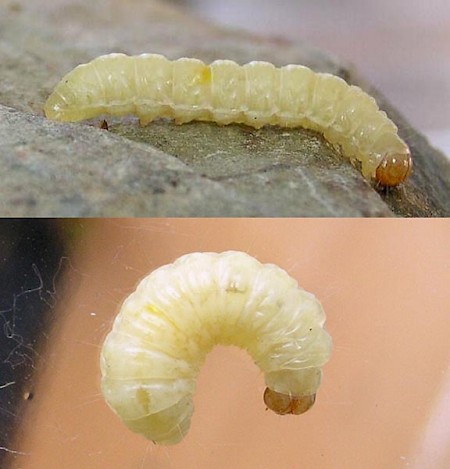28.01 BF647
Brown House-moth Hofmannophila pseudospretella
(Stainton, 1849)
Wingspan 15-26 mm.
A common inhabitant inside houses, this species is found throughout the British Isles and is often found on indoor walls as it begins to go dark.
It can be found on the wing at any time of the year but is commonest in summer. It is an Asian species introduced into Europe and many other parts of the world in the 1840s.
The general appearance is fairly constant but the species does show a large size variation, with a wingspan between 16 and 26 mm.
The larvae feed on detritus and other material that accumulates indoors behind skirting boards and other similar places.
- Larva: (Description I.F. Smith):
Food: Organic detritus, e.g. insect frass, wool, fur, skin, seeds, dead insects, nest debris and dried plants. Continuously brooded indoors. Some larvae live two years. Outdoors, hard frost destroys.
Length: about 10 mm.
Head: Reddish brown (artists? colour; Venetian red). Mouthparts and front edge of capsule darker; chestnut brown.
Prothorax (T1): Prothoracic shield transparent, tinted burnt ochre. Divided by a fine white medial line.
Mesothorax (T2): Two large shiny concolorous pinacula astride the midline, the posterior a forward pointing chevron. Only slightly sclerotised.
Metathorax (T3): Similar to T2, but pinacula smaller and less pronounced.
Thoracic legs: Translucent white. Tarsus tinted burnt ochre. Body: Translucent, in parts transparent, white, revealing Venetian red viscera in front two thirds of body.
Spiracles: Unobtrusive concolorous.
Abdominal pinacula: Large, unobtrusive, slightly sclerotised, shiny translucent white. Two pairs dorsal pinacula and two lateral pinacula on segments A1 to A7. (A8 and A9 not recorded in this description).
Setae: White.
Anal segment: Anal plate translucent white, tinted burnt ochre.
Prolegs: Translucent white with burnt ochre crochets.
Similar species: The larvae of several refuse-feeding species resemble each other and should be reared to confirm identity. e.g. compare 227 Monopis laevigella.

 UKMoths
UKMoths 







